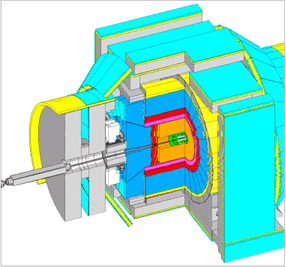Inquiring Minds
|
Physics at Fermilab main page | accelerators | collider experiments | neutrino physics | technology computing | theory | astrophysics | discoveries at Fermilab |
|
|
|
|
Particle detectors search through the flying debris of a particle collision to show us a world that our eyes cannot see. At first glance, Fermilab's two detectors, CDF (Collider Detector at Fermilab) and DZero, look more like hulking mechanical doughnuts than the complex electronic eyes of a huge microscope. Each detector weighs about 5,000 tons and towers three stories high. Inside the detectors' steel shells is an intricate array of devices, mind-boggling circuitry and sophisticated feats of mechanical engineering, arranged to record the most information possible about a particle's path, its energy and its charge. Watch a time-lapse gif-animation (230kb) of the CDF detector rolling into the collision hall. Because each kind of particle that escapes from a collision has its own distinctive behavior, the detectors search the particles' characteristic electronic signatures to determine whether they were created in a collision. To identify a top quark, for example, the detectors look for a high-energy electron, a muon, a neutrino and two jets of particles, squirts of particles created by quarks. Such a signature would suggest a collision in which a top quark had emerged before decaying into these much-longer-lived particles.
Delicate silicon devices and gas-filled tracking chambers are closest to and surround the beam pipe. They record the particles bursting outward from the central collision region. As particles pass through these devices, they rip electrons from the silicon or gas molecules. These electrons create an electric impulse, which scientists use to locate the track of a particle. A particle's path can thus be measured to a small fraction of a millimeter. Video on the assembly of the CDF silicon detector Leaving the central tracking devices, the particles enter the detectors' calorimeters, which measure their energy. As the particles traverse the calorimeters, they lose their energy to a succession of dense, absorbent materials. Passing through layers of heavy metal plates, they create showers of light. Detectors record the intensity of the light flashes, a measure of the energy of the particle that passed through. Most particles sputter out on their trip through the calorimeters. However, one persistent particle, the muon, usually muscles its way through the tracking devices and calorimeters. Special muon detection chambers are located outside the calorimeters and record the flight of these long-lived particles. The functions of a detector (video, 6 min.) Various types of detection devices It is impossible to record each of the million or more collisions that occur in the CDF and DZero detectors every second. Preprogrammed triggers weed out ho-hum events, registering details of only the most interesting of these collisions for later analysis. Since each collision produces tens of secondary particles, a detector actually monitors the activity of millions of particles every second, 24 hours a day. Of the billions of recorded signatures, a handful hold evidence for new phenomena. Needles in a haystack? Drops in the ocean? Metaphor strains to convey the painstaking difficulty of the search for evidence of the tiny number of particles physicists are seeking. Nevertheless, data from years of particle experiments have begun to shed light on the fundamental nature of matter and the evolution of the early universe. |
| last modified 2/23/2001 email Fermilab |
FRLsDFx9eyfrPXgV



 An intricate array of tightly packed devices, assembled like layers of an onion, makes up each detector, with the beam pipe of the Tevatron running through its center. A small Java-based
An intricate array of tightly packed devices, assembled like layers of an onion, makes up each detector, with the beam pipe of the Tevatron running through its center. A small Java-based